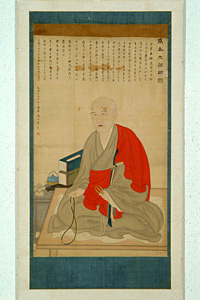Uisun facts for kids
| Uisun | |
 |
|
Quick facts for kids Korean name |
|
|---|---|
| Hangul |
초의
|
| Hanja |
艸衣
|
| Revised Romanization | Cho-ui |
| McCune–Reischauer | Ch'o-ǔ |
Cho-ui Seonsa (1786–1866) was a very important person in Korean history. Many people call him "The Saint of Korean Tea" or the "Father of Korean Tea." He was a Buddhist master who taught people about tea and Buddhism.
In the early 1800s, he showed many smart scholars the "Way of Tea." This was like a special tea ceremony. These scholars were not happy with the strict rules of Confucianism during the Joseon period.
Cho-ui was also a talented artist, calligrapher (someone who writes beautifully), and poet. He made strong friendships with famous people like Jeong Yak-yong and Kim Jeong-hui.
Contents
His Life Story
Early Years
Cho-ui Seonsa was born in 1786 in a village called Singi, in what is now South Jeolla Province. His family name was Jang. When he became a monk, his first name was Uisun.
At 16, he became a monk at Unheung-sa Temple. At 19, he had a special experience on Wolchul-san Mountain. After this, he became a full monk and received the name Cho-ui.
Besides studying, Cho-ui was good at painting. He could paint in both scholarly and Buddhist styles. He was also known for his beautiful Buddhist ritual songs and dances called Beompae.
Friendship with Jeong Yak-yong
Around 1806, Cho-ui might have met Dasan Jeong Yak-yong (1763-1836). Dasan was a famous scholar living in exile near Cho-ui's temple.
In 1809, Cho-ui spent several months with Dasan. He learned about the I Ching (a very old Chinese book) and classical Chinese poetry. They became very close friends. This was special because Dasan was a Confucian scholar, and usually such scholars did not get along with Buddhist monks.
Meeting Scholars in Seoul
Cho-ui first visited Seoul, the capital city, in 1815. But it was during a visit in 1830 that he became widely known. He made strong friendships with many highly educated scholars and government officials.
These friends included important people like Hong Hyeon-Ju and the famous calligrapher Chusa Kim Jeong-hui. It was very unusual for a Buddhist monk to be respected as a poet and thinker by these Confucian leaders. Monks were usually given a low social rank back then.
As a monk, Cho-ui was not allowed inside Seoul's city walls. So, he met his friends at Cheongnyangsa temple or a small hermitage outside the city.
Living at Ilchi-am
When Cho-ui was in his forties, he moved to a quiet mountain spot. In 1824, he built a small hermitage called Ilchi-am. He lived there alone for 40 years.
At Ilchi-am, he practiced a special kind of meditation. He also wrote about his meditation methods.
His Meditation Teachings
In Cho-ui's time, Korean meditation mostly focused on samatha. This means "calm abiding" or deep concentration.
Cho-ui's method was called Chigwan, which means "stopping and seeing." It combined samatha (concentration) with vipaśyanā (insight). Samatha helped people calm their minds and focus. Vipaśyanā helped them understand the true nature of things.
Cho-ui wrote a book called Seonmun sapyeonmaneo. In it, he explained that monks needed to add insight to their meditation. He believed this was a very important part that was missing.
His Writings About Tea
Cho-ui was also famous for his writings about tea. In 1828, he copied an old Chinese text about tea from the Ming dynasty.
Two years later, in 1830, he wrote his own book called ChaSinJeon (or Dasinjeon). This book was a simple guide on how to make and drink tea.
In 1837, he wrote another famous work called DongChaSong (or DongDaSong). This was a "Hymn in Praise of Korean Tea." Many tea lovers in Korea still celebrate him for this work.
In 1838, he climbed to the highest peak of Mount Kumgang. Later, King Heonjong gave him a special title: "The Great Monk Cho-ui, Master of Supreme Enlightenment."
Visits to Kim Jeong-hui in Exile
From 1840 to 1848, his friend Chusa Kim Jeong-hui was sent away to Jeju Island. Cho-ui visited him five times during these years. Once, he stayed for six months, teaching Kim Jeong-hui about tea and Buddhism.
When Kim Jeong-hui was finally allowed to leave, he visited Cho-ui at Ilchi-am right away.
His Final Years
Kim Jeong-hui died in 1856. A little later, Cho-ui, who was 71, visited his friend's grave.
Cho-ui stayed strong and healthy until the end. He continued to practice his meditation. In 1866, early in the morning, he asked his helper to assist him. He then sat in the lotus position and "entered Nirvana." This is the term used for the death of a Buddhist monk.

